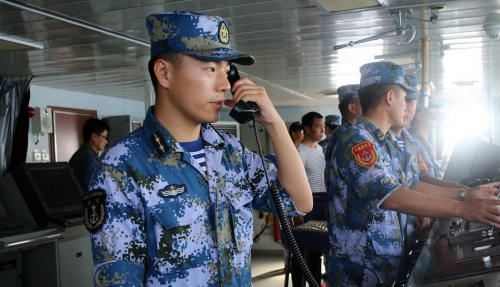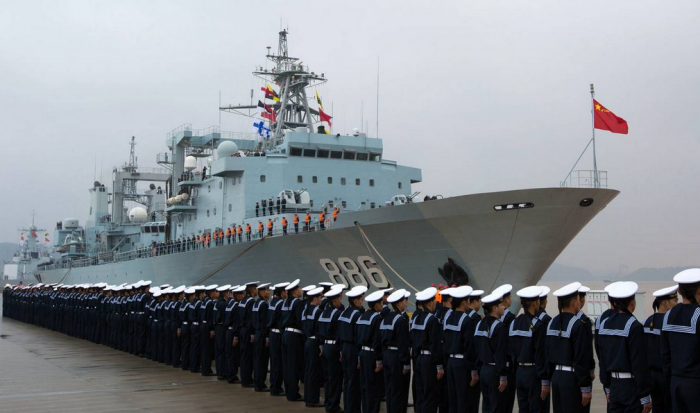On the first day of September, China staged a military parade of staggering size with 12,000 goose-stepping troops, missile 
Chinese sailors on the bridge
carriers, and jet over-flights as the centerpiece of a new 3-day national holiday commemorating the end of World War II. Simultaneously, President Xi Jinping announced a 300,000 reduction in the size of the army. It was, Xi said, a gesture to show that other countries have nothing to fear from a China “loyally committed to the sacred duty of safeguarding world peace”.
But it was the army that got trimmed. Just as with Obama’s “pivot” to the Pacific, so is the Pacific China’s pivot. “The traditional mentality that land outweighs sea must be abandoned”, states China’s new military strategy announced in May which explains the troop reduction. “Great importance has to be attached to managing the seas and oceans”.
“Safeguarding” is the key word in Mr. Xi’s pledge. China wants to take over the role so far played by the United States Navy of guarding the shipping lanes of the Pacific to guarantee that its own needs be met — China is a food importer and 80% of its oil passes through the South China Sea. Its method of safeguarding is to claim that sea as its own, building island outposts with an airfield, radar, and lighthouses, while ignoring the claims of neighboring countries to those same islands and reefs.
But China has much larger ambitions. It has designs to control the Pacific itself, as revealed by the successive semi-circles that show up on Chinese maps like dreamed-of spheres of influence, reaching to Okinawa and Guam and, ominously, even the Aleutians and Hawaii. China wants the U.S. out and is building a navy to make it happen. (See Part I of this series in these two articles).
just friends
The Chinese are transparent yet our military often seems clueless. China’s navy chief, Adm. Wu Shengli wants deeper exchanges with the U.S. Navy and has met four times with U.S. Chief of Naval Operations, Adm. Jonathan Greenert, over the past two years. The two have grown close. The stated objective is to develop guidelines for how Chinese and U.S. vessels can safely interact, but Adm. Wu openly seeks to learn carrier operations from the U.S. Navy and how better to educate Chinese naval officers. Their navy lacks combat experience and the admiral hopes the U.S. could help remedy its weakness. He wants to send his navy’s “experts” aboard an American aircraft carrier to learn about “maintenance and tactics.” He wants to send his officers to top U.S. universities and is miffed at rules that allow those officers to visit but not attend U.S. defense colleges.
Adm. Greenert is all for accepting Adm. Wu’s invitation for a U.S. aircraft carrier to pay a port visit to mainland China. One can readily imagine successive waves of Chinese naval officers touring every inch of the ship with Bluetooth devices hidden in their hats sopping up terabytes of data from ship communications and equipment. Pentagon officials have never been allowed to visit the headquarters of the Chinese armed forces.
The Pentagon nixed the port visit, for obvious good reason. Invited in 2014 for the first time to participate in the Rim of the Pacific naval exercises, maneuvers attended by 22 nations that sent over 50 ships, the Chinese were discovered to have sent an electronic intelligence ship to spy on the exercises.
What is symptomatic that “guidelines” for safe interaction don’t seem to be the motive for Adm. Wu’s overtures is China’s unwillingness to reach agreement on a code of conduct for unexpected encounters between military aircraft to avoid serious conflict. This avoidance is at precisely a time when the U.S. will test China’s territorial claims in the South China Sea with fly-throughs. It suggests that China wants no rules to inhibit the provocative behavior we recounted in Part One.
A code for naval encounters was signed by 21 Western Pacific powers a year ago April, China among them. It is voluntary, though, and a senior Chinese naval officer said that Beijing has signaled that it may not
follow the code if it encounters foreign ships in the disputed waters of the East and South China seas that it now claims for itself.
Adm. Gary Roughead, the retired U.S. Chief of Naval Operations, says that Wu “doesn’t want to build a navy that’s equivalent to the U.S. He wants to build a navy that surpasses the U.S.”
In the op-ed cited earlier, Gen. Clark said a young, well-connected Communist Party leader said to him, “China knows that you and Britain were best friends, and Britain gave you leadership of the world; China wants to be America’s best friend, so you will give us leadership of the world.”
goodfellas
America fell hard for the “peaceful rise” assurances, heedlessly importing staggering quantities of Chinese goods while China covertly used the proceeds of vastly imbalanced trade to build the military that is meant to drive us from the Pacific. From 9/11 forward, all attention has been paid to the Middle East. The Bush administration ceased speaking of China as a “strategic competitor” in order not to provoke, and we rationalized that a strong partner helping to keep the sea lanes open and free of pirates meant our carrier groups could better be deployed in the Persian Gulf.
China saw unparalleled opportunity. The threat of the Soviet Union on its border had collapsed in the 1980s. As this century dawned, America began to look like a failed state, its debt rising from about $6 trillion in 2000 to over $18 trillion today, wasting assets in the Mideast for almost all that time, with a government so polarized that it had even shut down. The U.S. looked vulnerable to being replaced as the world’s leader.
the view from china
Our strategy with Russia during the Cold War convinces China that, once again, the U.S. is following a policy of containment. China’s answer, driving its naval and advanced missile buildup, is “sea denial” — to push the United States away from the mainland and ever further into the Pacific. “It is for the people of Asia to run the affairs of Asia, solve the problems of Asia and uphold the security of Asia”, Xi Jinping signals the West. The question is the extent of China’s plot for its future suggested by the term it uses: “far sea defense”. In what the Pentagon calls its “A2/AD”, or or “anti-access/area denial”, policy for the western Pacific, does China have in mind challenging and targeting our air-force bases in Okinawa, South Korea and even Guam as we covered here?
Beginning with Deng Xiaoping, China adopted a policy of “peaceful rise”. China would present itself as a peaceful nation interested only in trade and investment with no sign of threat even to Taiwan. The United States was so overjoyed with cheap goods that it now seems as if everything we own has “Made in China” stamped on the back. Now that China has achieve tremendous growth and expanded its military with the proceeds of that trade, it has given notice that the “peaceful” part of “peaceful rise” is no longer guaranteed. An official strategy “white paper”, which China even had translated into English lest we overlook it, put it more forcefully, that China promises “to seize the strategic initiative in military struggle, pro-actively plan for military struggle in all directions and domains, concentrate superior forces, and make integrated use of all operational means and methods.” Xu Guangyu, a retired major general involved in arms control, gives notice that “China will actively build up its military capability and deterrence, just to make sure no one dares fight with us”.
america’s response
As China’s power rises, the concern — made clear by Chinese actions recounted in the first part of this series — is that China will begin to disrupt the world order carefully set down after World War II. At least in its part of the world it will begin to dictate whose ships can sail where, what areas are forbidden to fly through, who gets to trade with whom and what resources are restricted to all but them.
We counter this with bluster — Defense Secretary Ashton Carter saying, “”We will remain the principal security power in the Asia-Pacific for decades to come” — and timidity from elsewhere — a State Department spokesman saying the Obama administration would “continue to monitor China’s military developments carefully”.
After years of Chinese cyber theft of U.S. technology reaching a crescendo this year with their spiriting away the complete dossiers of hundreds of thousands of persons working for the government, President Obama said, on the eve of Xi Jinping’s visit to Washington that he is “preparing a number of measures…countervailing actions” in retaliation. The boom would not be lowered before the visit, but afterward is increasingly likely.
Or perhaps not. “My hope,” Mr. Obama added, “is that it gets resolved short of that.” So much for retaliation.
The Pentagon is reportedly weighing the idea of sending ships and aircraft within 12 nautical miles of the rocks and reefs in the South China Sea that the Chinese have been turning into bases. Staying 12 miles off is as good as acknowledging that China owns the disputed artificial islands. Even so, “some U.S. military officials fear that would be ‘needlessly provocative'”. So Secretary of State John Kerry has simply asked the Chinese to stop making islands. Ashton Carter said China’s actions in the area run counter to “international norms that underscore the Asia-Pacific’s security architecture”. Such harsh words!
In his recent book, “The Hundred-Year Marathon — China’s Secret Strategy to Replace America as the Global Superpower”, Michael Pillsbury, a China expert who has advised every president since Nixon, has this to say: “I was so gullible. We believed that American aid … would help China become a democratic and peaceful power,” but “every one of the assumptions behind that belief was wrong—dangerously so.”
Some voices counsel doubling down on laser weapons and anti-missile technology, developing a long-range bomber, clamping down on corporate technology transfers, and imposing a tariff on all Chinese goods in retaliation for cyber thefts.
Others advise drawing China closer by emphasizing our common interests and persuading them to take on a more responsible role in world affairs — as with the climate discussions Obama expects to have with President Xi on his visit — by taking on their share of the burden of global governance. Nonsense, effectively says a recent Council on Foreign Relations report by former U.S. diplomats Robert Blackwill and Ashley Tellis. These past four decades of bringing China along and welcoming them into the World Trade Organization, whose rules they would flout, have been a mistake. They say that China isn’t interested in becoming a “responsible stakeholder” in any U.S.-led liberal international order, period.
Still others advise the U.S. to cede primacy in the region to China and make the best deal we can before they make further military progress. A policy of containment would be far too costly for a U.S. so deeply in debt — this time against a powerful China, not a weakened Russia — and would trigger a new Cold War. In making a deal we could offer to take such steps as withdrawing troops from Korea and leaving the area’s waters in exchange for China pledging not to attempt a takeover of Taiwan. That would require trusting a nation that has stolen our intellectual property, counterfeited our goods, grabbed our industrial and military secrets… It’s a shame these advisers have not heard of the aphorism that begins, “Fool me once…”.
Oct 27 2015 | Posted in
World |
Read More »


